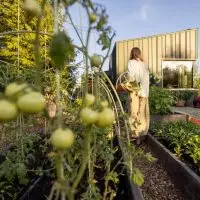Rethinking Agribusiness: Integrating Sustainability, Localisation, Circular Economy, and Food Technology

Rethinking Agribusiness is Imperative for Sustainable Food Security.
1. Introduction: The Imperative for Sustainable Food Systems
The global food system is at a critical juncture, facing compounding challenges such as climate change, resource depletion, biodiversity loss, and rising food insecurity. Traditional linear models of agricultural production and consumption are proving unsustainable. To ensure long-term resilience and ecological stability, we must reimagine food systems through the lenses of sustainability, localisation, circular economy principles, and food technology.
2. Localisation vs. Globalisation: Building Resilient Food Networks
Globalisation has created complex, lengthy supply chains that prioritise scale and cost over sustainability and food sovereignty. While global trade has enabled the year-round availability of diverse produce, it has also led to increased food miles, weakened local farming economies, and reduced the freshness and nutritional quality of food.
In contrast, localisation emphasises regional production and shorter supply chains. Locally grown food typically has lower transportation emissions, stronger ties between consumers and producers, and enhanced food security in times of global disruption. Studies indicate that food travels an average of 2,400 kilometres from farm to plate, whereas local food systems can reduce that distance by over 90%.
3. Embracing the Circular Economy in Agriculture
The circular economy model promotes the regeneration and reuse of resources, moving away from the extractive, wasteful nature of linear economies. In agriculture, this involves rethinking waste as a resource — composting organic matter, recycling water, using byproducts as feed or fertiliser, and designing farming systems that emulate natural cycles.
Practices like regenerative farming, agroecology, and closed-loop systems are helping rebuild soil health, retain water, reduce chemical input, and create more resilient farming models. By turning waste into value — whether through compost, biochar, or nutrient cycling — farmers enhance ecological function while improving productivity.
4. The Hidden Cost of Large-Scale Farming: Soil Degradation and Chemical Dependence
Industrial-scale agriculture, typically aligned with globalised food systems, depends heavily on synthetic inputs like pesticides, herbicides, fungicides, and chemical fertilisers. Though these inputs have historically boosted short-term yields, they have caused extensive environmental damage:
Soil degradation: Continuous monocropping and chemical applications deplete organic matter, disrupt microbial ecosystems, and cause compaction and erosion.
Water pollution: Fertiliser runoff leads to algal blooms, oxygen-deprived aquatic zones, and contaminated drinking water.
Biodiversity loss: Pesticides affect non-target organisms, including pollinators and beneficial soil microbes.
Climate impact: Degraded soils release carbon, while nitrogen-based fertilisers contribute to nitrous oxide emissions, a potent greenhouse gas.
According to the FAO, one-third of the world’s soils are already moderately to severely degraded. This compromises not only food production but also the broader ecological integrity of farming landscapes.
5. Connecting the Dots: Soil Health, Sustainability, and the Circular Food Economy
Soil degradation is more than an agronomic issue; it’s a systemic problem exacerbated by global supply chains, monoculture-driven economies, and a disconnect between consumers and the land. The depletion of soil mirrors the depletion of natural capital across all resource sectors.
This is where the principles of localisation, circular economy, and technology-enabled regeneration intersect. Soil restoration practices — when deployed locally — feed into both ecological recovery and community resilience. By closing loops (e.g. food waste to compost to soil amendment), we improve nutrient retention, reduce external inputs, and strengthen the feedback between production and consumption.
6. What Can Be Done Locally: Restoring Soil Health Through Small-Scale Action
Unlike industrial farms reliant on fixed infrastructure and global input supply chains, small-scale growers and community-based initiatives can pivot to regenerative practices more readily:
Localised Soil Restoration Strategies:
Composting: Transforms organic waste into high-value soil amendments.
Cover cropping: Prevents erosion, fixes nitrogen, and builds biomass.
No-dig or low-till methods: Preserve soil structure and microbial life.
Mycorrhizal fungi and microbial inoculants: Improve nutrient uptake and root health.
Natural fertilisers: Such as seaweed extract, worm castings, and compost teas.
Mulching and biochar: Enhance moisture retention and carbon storage.
These methods not only mitigate damage but actively rebuild ecosystems, creating a foundation for long-term sustainability. They also provide educational and economic opportunities for communities looking to localise food production.
7. Food Technology: Driving Innovation in Agribusiness
Emerging food technologies offer new tools for sustainability. Innovations in precision agriculture, AI-driven monitoring, and digital marketplaces allow farmers to reduce inputs, enhance traceability, and minimise waste. For example:
Soil sensors optimise irrigation and fertiliser application.
Drones monitor crop health, reducing unnecessary pesticide use.
Blockchain ensures transparency in supply chains.
These tools are most effective when used to support ecological practices rather than override them. The goal is to enable high-resolution, localised decision-making that complements soil and ecosystem health.
8. Case Study: ICAR-CCRI’s Citrus Waste Circular Innovation
The ICAR-Central Citrus Research Institute in India has pioneered citrus waste recycling by turning discarded fruit peels into bio-degradable packaging and value-added products like jams and nutraceuticals. This model demonstrates how food waste can be transformed into a resource that creates value while reducing pressure on landfills and the environment.
It also showcases the potential of merging scientific innovation with circular design principles to support both sustainability and rural economic development.
Source: Times of India – ICAR-CCRI Circular Citrus Project
9. Conclusion: Regenerative Agribusiness for a Sustainable Future
The path forward for agribusiness is not bigger, faster, or cheaper — it is smarter, fairer, and more ecologically grounded. Integrating soil regeneration, local food systems, circular economy strategies, and adaptive food technologies allows us to restore ecological balance while feeding communities more sustainably.
Each small-scale compost pile, seed-saving initiative, or smart irrigation controller becomes part of a larger solution — one that respects planetary limits, supports local economies, and delivers food that nourishes both people and place.
Further Reading & References
FAO: Status of the World’s Soil Resources – https://www.fao.org
Ellen MacArthur Foundation: Circular Economy in Food – https://ellenmacarthurfoundation.org
Regeneration International: https://regenerationinternational.org
Local Futures – The Economics of Happiness: https://www.localfutures.org
Kiss the Ground (Documentary): https://kissthegroundmovie.com

